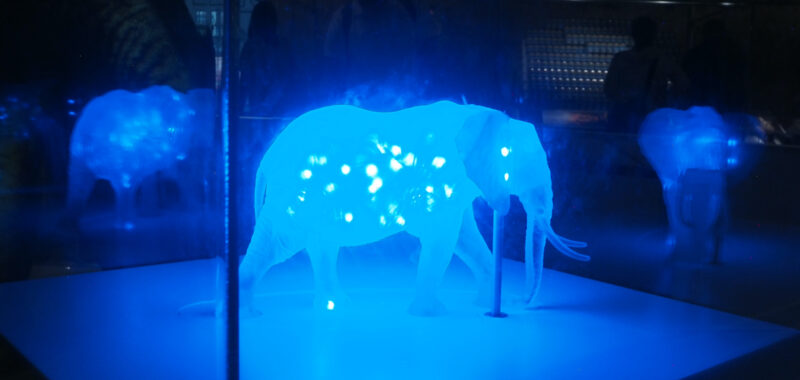Until I saw The Secret World of Elephants at the American Museum of Natural History, I thought the wooly mammoth was the coolest elephantine ancestor I’d missed out on seeing alive. Turns out I was wrong: I actually deeply wish I’d gotten to meet a dwarf elephant. Standing less than four feet in shoulder height, their remains have been found throughout the Mediterranean. Thankfully the curators of the special exhibition have included a replica, revealing just how darn cute the creature is.
Less cute are the real world fossilized remains of the jaws of a mastodon and a Columbian mammoth. While mastodons and mammoths are often confused, the teeth are very different — the former’s are large and round for consuming soft leaves and twigs, while the latter’s have hard ridges to grind grass. Both look like they belong to mouths that could easily swallow a baby dwarf elephant.

The Secret World of Elephants is filled with interactive activities and both tactile and verbal information about our gargantuan cousins that are as much fun for grown-ups as they are for kids. One section, The Science of Poop, takes us through the size of elephant dung and its role in its ecosystems, with models that have removable tops. By turning open the top to look into the sizable droppings of an African savanna elephant, for example, we see that it serves as food for butterflies and beetles.
Another tactile section, Let’s Rumble!, reveals the remarkable sensitivity of elephant feet. A small installation enables visitors to experience, by placing their hand onto a circle, the infrasound, or low-frequency vibrations, that elephants emit. Humans can feel these rumblings but not hear them, and a didactic clarifies how the sound travels through the ground, up the feet, and into the ears. (If you’ve ever used bone conduction headphones, I imagine the experience might be similar.)
And if feet can serve as ears, then ears can serve as cooling mechanisms. In How the Ears Cool the Body, visitors can press a button to watch how blood flows into an elephant’s thin ears, allowing excess heat to escape.

The latter part of the exhibition takes us away from elephant science and into the many ways humans relate to them, from labor to worship to war. One section presents chess figures, puppets, and coins, along with a statue of Ganesha, a beloved Hindu god with an elephant head and four human-like arms. More sobering is Weapons of War, which shows how humans began using elephants in military battles in Asia some 5,000 years ago. One set of puppets depicts the Trưng sisters, who rode elephants and led an army to drive out invading Chinese forces.
As charismatic megafauna, elephants have gripped the human imagination for thousands of years, and The Secret World knows this, with large replicas and interactive installations that help us grasp the sheer size and wonder of these magnificent creatures. But even as humans situate them as objects for projection, study, and labor, they are also sentient beings with individual — one could say secret — emotions, dispositions, and relationships. In the “Deep feelings” section, the curators explain how elephants express love by intertwining their trunks, take care of the ill by feeding them, and appear to mourn the dead by returning to their bodies to touch the remains.
One story stood out to me about Shirley and Jenny, two Asian elephants raised in the same circus, separated, and then reunited 20 years later at the Elephant Sanctuary in Tennessee: “The two called out to each other in excitement and touched each other again and again with their drunks. Shirley and Jenny remained close companions for the next seven years, until Shirley died at age 72.”







The Secret World of Elephants continues at the American Museum of Natural History (200 Central Park West, Upper West Side, Manhattan) through November 1. The show was curated by Ross MacPhee, curator emeritus in the Museum’s Department of Mammalogy, with consultation by Raman Sukumar, honorary professor at the Centre for Ecological Sciences, Indian Institute of Science; and Alexandra van der Geer, a researcher at the University of Leiden, Netherlands.

